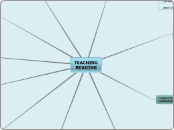TEACHING
READING
APPROACHES TO TEACHING
READING SKILLS
BOTTOM-UP AND TOP-DOWN PROCESSING
Bottom-up processing the readers have
to recognize some linguistic signals and use
them
Data-processing requires a specific knowledge
of the language, readers select signals and
make sense
Top-down or conceptually drive processing
readers express their own intelligence and experience
to understand the text
SCHEMA THEORY AND BACKGROUND KNOWLEDGE
THE ROLE OF AFFECT AND CULTURE
THE POWER OF EXTENSIVE READING
ADULT LOTERANCY TRAINING
TYPES OF WRITTEN
LANGUAGE
Non-fiction (reports, essay, article)
Fiction (Novels, poetry)
Letters
Newspaper
Academic Writing
Billd (Financial Statemebt)
CHARACTERISTICS OF WRITTEN LANGUAGE
Permanence
Processing Time
Readers can read in their own rhythm
Distance
Readers have to interpretate
the language
Orthography
Readers must perceive every
single things and
"Read between the lines"
Complexity
Readers must return to adjust their
cognitive perceptions to select the
useful information.
Vocabulary
Some meanings could be
predicted by the context
Formality
Related to elaborate texts
STRATEGIES FOR READING
COMPREHENSION
Identify the purpose in reading
Use graphemic rules
(Beginning level)
Use efficent silent reading techniques
(Intermediate to advanced)
Skim the text (Main ideas)
Scan the text
(Specific Information)
Use semantic mapping or clustering
Guess (Meaning, grammatical,
cultural reference)
Analyze Vocabulary
Literal and Implied meanings
Capitalize on discourse markers
to process relationships
READING ACTIVITIES
Using Newspaper
Following Intructions
Poetry
Predicting from words
and pictures
Differente Responses
READING PRINCIPLES
Encourage students to read whenever possible
Students must engage with the readings
Encourage students to respond to
the content of a text
get an idea of the topic of the text
Relate the readings with activities
READINGS LEVELS
Depending on the level it is possible
to offer a specific text for every learner
The most useful is to read Authentic texts
REASONS FOR READING
Study purpose
Simply for pleasure
Useful for language acquisition
Positive effect in vocabulary
knowledge and spelling
Provide good models
READING AND SOCIAL CONTEXT
The learners are related with
reading to motivate it is for
acquiring information and
enjoying the reading
Be a part of the community
of readers
TYPES OS CLASSROOM READING
PERFORMANCE
Oral and silent reading
-Chek pronuntiation
-Is not an authentic language activiy
Intensive and extensive reading
INTENSIVE
there are some activities that
focus in the linguistics or in semantic details
EXTENSIVE
Is performed to achieve a general
understanding of a longer text than usual
